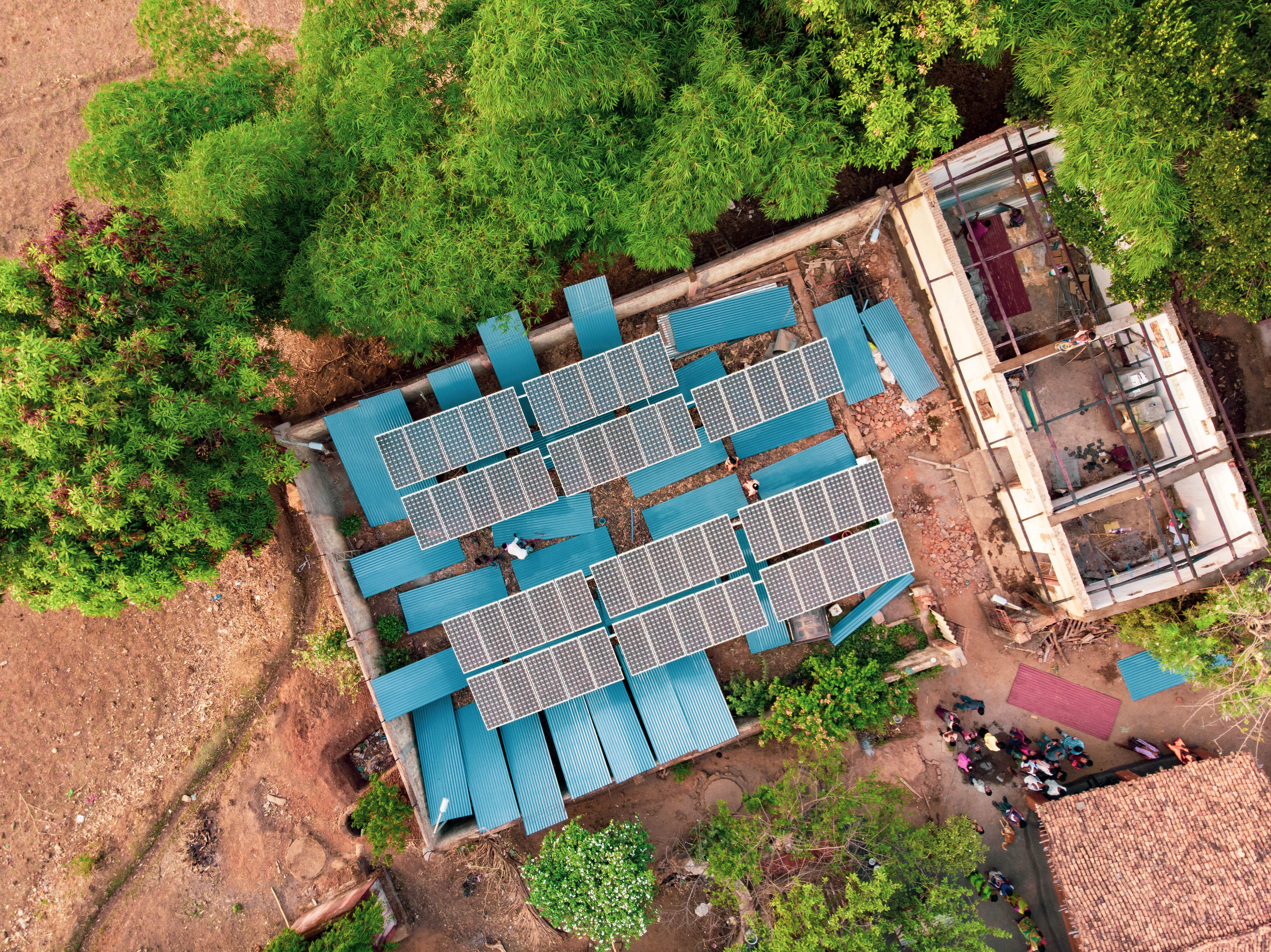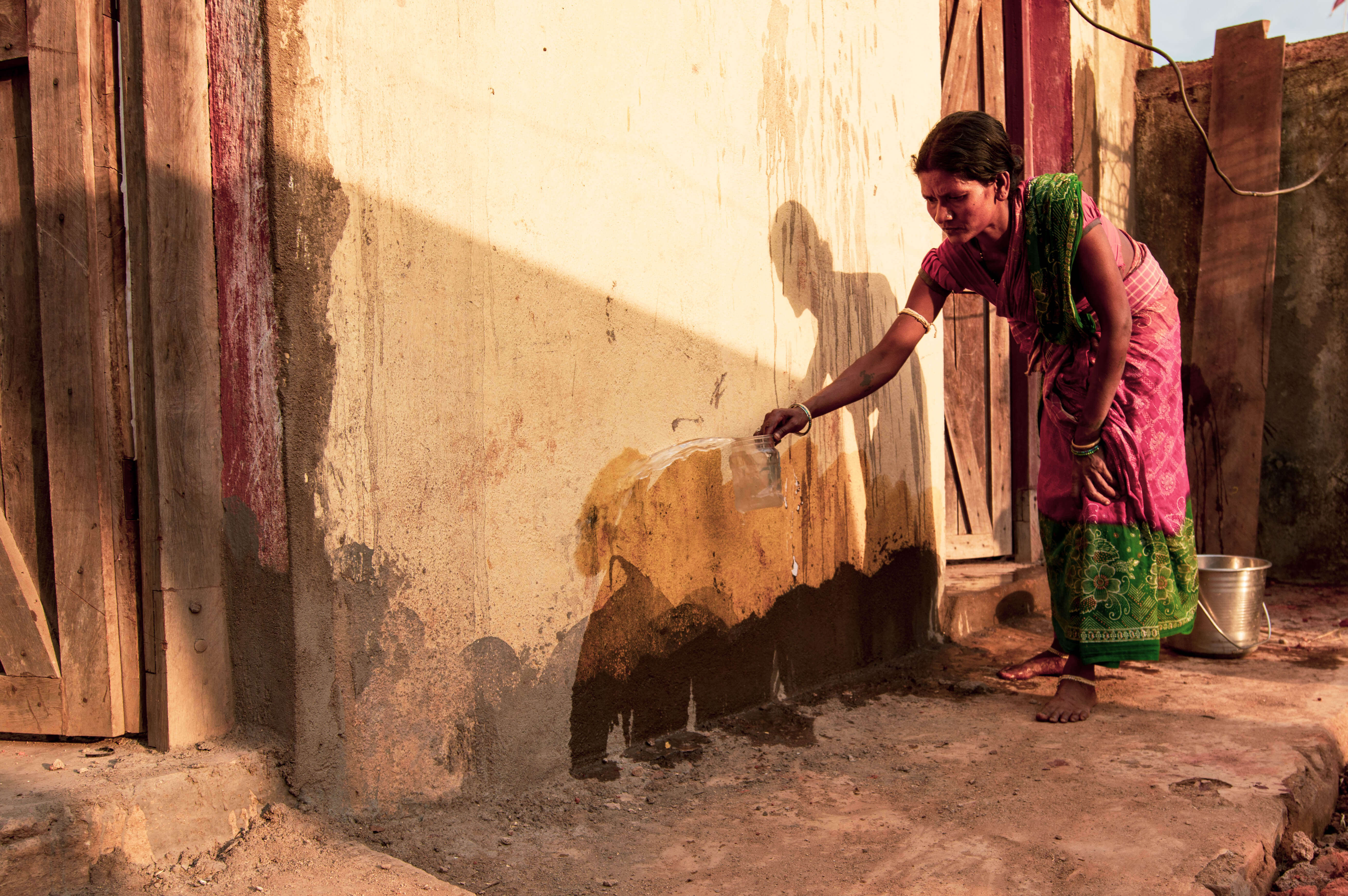Revival of the Maligaon Solar Project
FeatureBy Eshaan Patheria, Liby Johnson
10 January 2020

Aerial view of the solar panels over the powerhouse in Maligaon, Kalahandi. Photograph by Ajaya Behera.
Maligaon village with its inhabitants of 45 households is located at the Thuamul Rampur block of the Kalahandi district. Gram Vikas has been a longstanding partner of Maligaon village in its holistic development. The range of development works undertaken by us at the household level in three decades include building toilets and bathing rooms, potable water supply system, electrifcation and enrolling children in the residential schools of Gram Vikas.
In 2009, Gram Vikas implemented a solar micro-grid for home-electrifcation in Maligaon. The existing electricity grid’s nearest point of connection was 30 kilometres away from Maligaon. The main system component of the solar grid included a 9.63 kW total photovoltaic (PV) array capacity, 96 kWh tubular lead-acid battery bank and an Urja Bandhu (charge controller that makes the fixed amount of energy available daily) for each home. Each household received a daily quota of electricity based on a fixed monthly charge.
Gram Vikas trained a local operator to run the system. However, in 2013, the solar micro-grid failed due to the premature expiry of the tubular lead acid batteries. The depletion was caused by two factors, manufacturing defects and improper maintenance of the batteries by the local operator.
In 2014, Maligaon village was connected to the main electricity grid, but electricity supply was marred by frequent blackouts and outages, especially in the rainy season.
Drawing cues from its earlier experience, Gram Vikas decided to renew the solar micro-grid project by setting up a sustainable system. Gram Vikas focused on using modern technology available in this segment and putting effective community-management in place.
The earlier experience showed that depending on a sole operator for the upkeep of the solar grid was also a major factor behind the failure of the project.
Eshaan Patheria, an SBI Youth for India Fellow and a Harvard graduate, led the work to modify the existing technology and mobilise the community to adopt a better management system. The key features of the revised technology include:
• Long lasting Lithium Ferro Phosphate (LFP) batteries
• Three phase power to withstand heavier loads
• Additional seven kilowatts of solar panels to increase the array’s capacity and lifespan
• Smart metres to collect real time data on energy consumption at the household level to ensure rational usage and payment
Technical personnel from Gram Vikas will conduct a monthly audit to keep a tab on the grid’s operational aspects. Mahindra & Mahindra, the technology provider, will undertake annual maintenance of the grid. A new load survey will be done every year to calibrate the system to ensure that supply and demand are always in balance.
Along with the village community, we analysed the lessons from the past experience of community management and the reasons for failure. The women of Maligaon had witnessed the entire revival process and realised its all-round uplifting impact on the village. They have taken up the overall responsibility of the solar grid’s regular upkeep.

Jamuna Patel, mother of four, sprinkles water on new plaster of the wall of the powerhouse to help it cure. Photograph by Ajaya Behera.
A team of women have been selected and trained on day-to-day functioning and essential features of solar engineering. The team will be given a fixed monthly remuneration for the responsibilities, including managing the equipment, facilitating payments through the smart metres, and maintaining a daily log of the electricity consumption of each household.
The Village Development Committee will oversee these efforts and intervene to address any situational confict arising from the project. Monthly financial audits will be done for the sale of recharge coupons.
Till the operational aspects are stabilised, a Gram Vikas staff member will support with the regular operations and handholding of the women’s groups. We expect to handover complete operational responsibilities to the village by March 2021.
The renewal work which started in September 2018 was completed on 8 September 2019, when the solar micro-grid was commissioned. CAT International Projects and 110 generous individual donors through the crowdfunding campaign provided valuable financial support for the revival of this project.
The renewed solar grid has enabled the villagers to use electricity beyond simple household needs, such as irrigation, streamlining other agricultural practises, and lighting up streets. The multiple uses of the grid have also resulted in a holistic improvement in the living standards of the village.
A couple in Maligaon, Kalahandi, in their newly lit up house. Photograph by Ajaya Behera.
ACKNOWLEDGEMENT
Special thanks to the 110 donors from within and outside India who contributed money and rallied support for the initiative. The team of Eshaan Patheria, Dulhaba Odandra, Ashutosh Bhat, Gokul Govind R, Narahari Rout, Sanjay Baral, Debaraj Sahoo, Malaya Panda, Sanyasi Palai, Bighneswar Panda, and 55 families in Maligaon worked tirelessly to bring life back to Maligaon. Dibya Alok and Ajaya Behera supported the crowdfunding campaign.
ABOUT THE AUTHOR
Eshaan Patheria led the micro-grid renewal effort as a SBI Youth for India Fellow with Gram Vikas. Liby Johnson is the Executive Director of Gram Vikas.
RELATED BLOGPOSTS
Rediscovering the nutritional power of Wild Edible Plants with the Saura Adivasis
An SBI Youth for India Fellow works with the Saura Adivasis by reviving their knowledge of wild edible plants, promoting a micronutrient-rich diet and strengthening their connection to traditional food sources.
A remote Adivasi village takes steps to ease water stress through efficient groundwater management
A community-led approach ensures water security, sustaining life in harmony with the environment.
From stigma to sustainability: Transforming menstrual health in schools and villages of rural Odisha
A menstrual health initiative promotes eco-friendly practices while empowering young girls and women with sustainable health solutions.